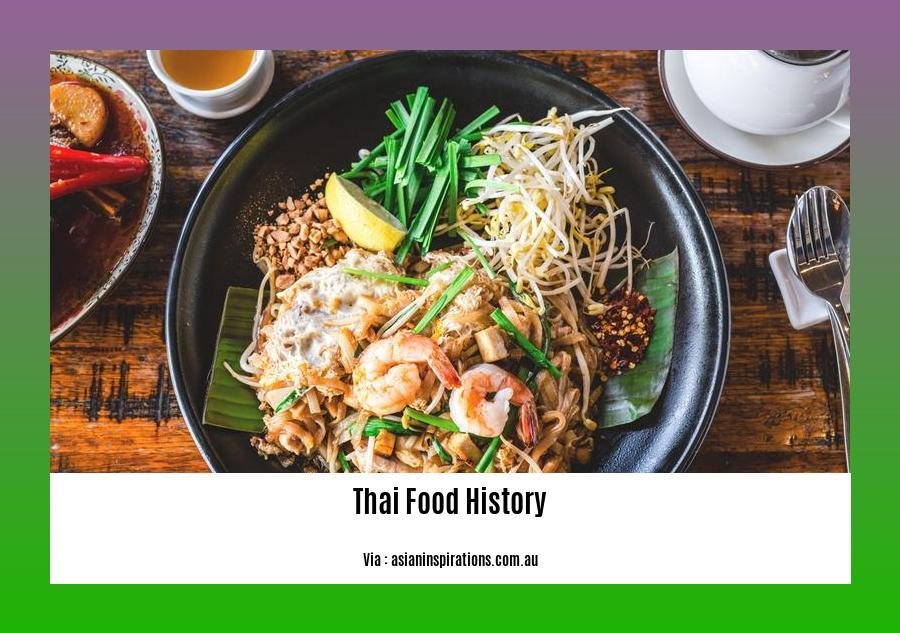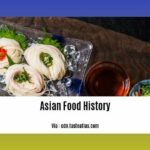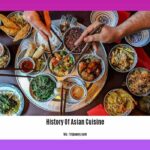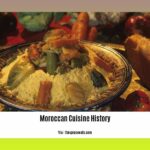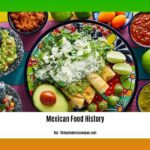Embark on a tantalizing journey through the history of Thai cuisine in Unveiling the Enchanting History of Thai Cuisine: A Culinary Journey Through Flavors and Traditions. Together, we’ll explore the unique blend of flavors and aromas that define this vibrant culinary landscape and uncover the cultural influences that have shaped Thai food into the beloved cuisine it is today.
Key Takeaways:
- Thai cuisine, a culinary masterpiece, is an amalgamation of diverse influences, such as Chinese, Indian, and Southeast Asian flavors, creating a unique and delectable cuisine.
- Fresh ingredients, a harmonious balance of flavors, and aromatic herbs and spices are the cornerstones of Thai cooking, resulting in tantalizing dishes.
- Thailand’s diverse geography and cultural heritage have resulted in regional variations in Thai cuisine, each boasting its own culinary treasures.
- Beloved dishes like Pad Thai, Tom Yum Goon, and Green Curry have gained international fame for their exquisite flavors.
- Thai cuisine has earned worldwide recognition not only for its delectable taste but also for its health benefits, making it a favored choice among food enthusiasts.
Thai Food History
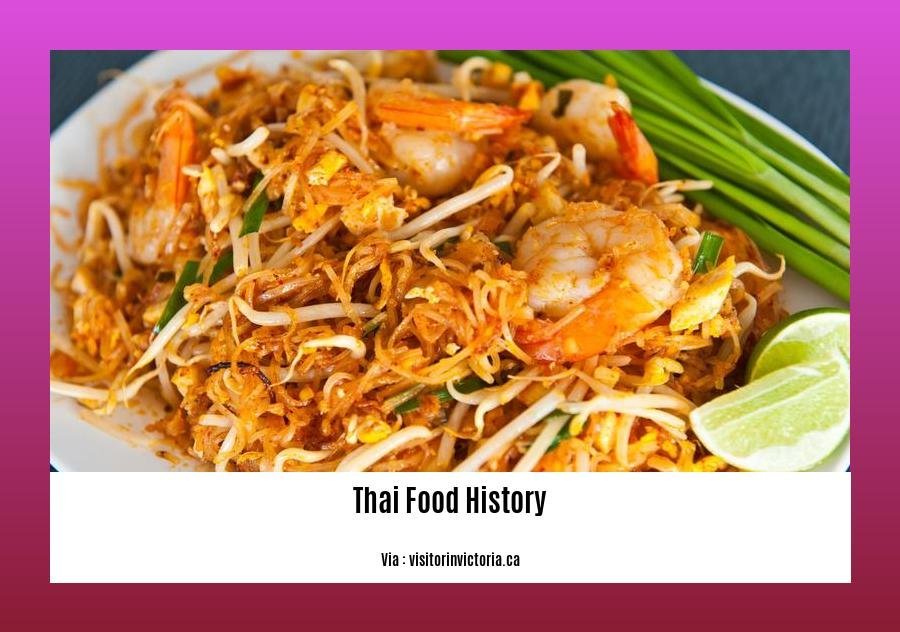
Embark on a tantalizing journey through the Thai food history, a culinary tapestry woven with diverse influences and vibrant flavors. Let’s explore how this beloved cuisine evolved into a global sensation.
Culinary Crossroads: The Interwoven Roots of Thai Cuisine
Thailand’s strategic location at the heart of Southeast Asia transformed it into a culinary crossroads, where culinary traditions from China, India, and neighboring countries intertwined to create a unique gastronomic identity.
Ancient Origins: The Indigenous Flavors of the Land
Thailand’s rich agricultural heritage laid the foundation for its cuisine, with indigenous ingredients like rice, coconut, and an array of herbs and spices forming the backbone of many traditional dishes.
The Royal Influence: Cuisine Fit for Kings
The royal courts of Thailand played a pivotal role in shaping the country’s gastronomy, with royal chefs experimenting with new flavors and techniques to create exquisite dishes fit for the monarchy.
Regional Delights: A Culinary Tapestry of Diversity
Thailand’s diverse geography and cultural heritage resulted in regional variations in cuisine, with each region boasting its own unique specialties, from the fiery curries of the south to the delicate noodle dishes of the north.
Global Recognition: Thai Cuisine Conquers the World
In recent decades, Thai food history has gained international acclaim, captivating taste buds worldwide with its harmonious blend of sweet, sour, salty, and spicy flavors.
The Secret Ingredients: Unveiling the Essence of Thai Cuisine
The Magic of Freshness: Thai cuisine celebrates the vibrant flavors of fresh ingredients, with an emphasis on seasonal produce and herbs.
The Art of Balance: Thai dishes are renowned for their delicate balance of flavors, where sweet, sour, salty, and spicy elements intertwine to create a harmonious symphony.
The Symphony of Herbs and Spices: Thai cooking harnesses the aromatic power of herbs and spices, from the ubiquitous lemongrass to the fiery chilies, to create complex and captivating flavor profiles.
The Coconut Connection: Coconut milk, with its rich and creamy texture, plays a starring role in many Thai dishes, adding a touch of tropical indulgence.
The Magic of Rice: Rice, the staple grain of Thailand, is not just a side dish but an integral part of the Thai dining experience, served alongside curries, stir-fries, and soups.
The Future of Thai Cuisine: A Culinary Odyssey Continues
As Thai food history continues to evolve, it embraces modern influences while remaining true to its culinary heritage. Thai chefs around the world are pushing the boundaries of Thai cuisine, creating innovative dishes that pay homage to the past while embracing contemporary trends.
The journey of Thai food history is an ongoing saga, a testament to the enduring power of culinary traditions and the boundless creativity of Thai chefs.
Looking to relish in the flavors of Spain? Dive into the fascinating history of Spanish food and discover the culinary evolution that brought paella to your plate! spanish food history
Traditional Mexican attire is a spectacle to behold! Get a glimpse into the history of traditional Mexican clothing and understand why their vibrant colors & intricate designs are so iconic. traditional mexican clothing history
The introduction of chili peppers by Portuguese traders in the 16th century revolutionized Thai flavors
Chilis may be the epitome of Thai flavors today, but their story in Thailand started later than one might think. Before the Portuguese traders arrived in the 16th century, Thai cuisine was a world without chili peppers. With their introduction of these fiery fruits, they set in motion a culinary transformation that would shape the very essence of Thai cuisine.
The Portuguese were instrumental in bringing chili peppers from the Americas to Asia. Their trading routes, driven by a quest for spices and other exotic goods, carried these peppers to the shores of Thailand, where they quickly gained popularity. Chili peppers, with their unique blend of heat, flavor, and nutritional value, found a ready audience among the Thai people.
The integration of chili peppers into Thai cuisine was a gradual process, influenced by factors such as geography, climate, and culinary preferences. In the central region, where the influence of the royal court was strong, chili peppers were initially used sparingly, their heat providing a subtle accent to dishes. As they moved south, however, chili peppers embraced a bolder role. The tropical climate and spicy food preferences of the southern Thai people led to the emergence of fiery curries and pastes that showcased the pepper’s full potential.
The versatility of chili peppers allowed them to seamlessly integrate into various Thai cooking techniques. They added a spicy kick to stir-fries, curries, and soups. Dried chili peppers became essential ingredients in pastes and relishes, infusing dishes with a smoky depth of flavor. Fresh chili peppers, with their vibrant colors and crisp texture, became indispensable garnishes, adding visual appeal and an extra burst of heat.
Key Takeaways:
The introduction of chili peppers by Portuguese traders in the 16th century marked a pivotal moment in the evolution of Thai cuisine.
Chili peppers quickly gained popularity in Thailand due to their unique blend of heat, flavor, and nutritional value.
The integration of chili peppers was influenced by regional factors, with the central region embracing a more subtle use of peppers, while the south wholeheartedly embraced their fiery potential.
Chili peppers’ versatility allowed them to integrate into various Thai cooking techniques, from stir-fries and curries to pastes and relishes.
They brought a spicy kick, smoky depth, vibrant colors, and an extra burst of heat to Thai dishes, transforming the culinary landscape of the country.
Citations:
Legal Nomads: A Brief History of Chili Peppers
The establishment of the Rattanakosin Kingdom in the 18th century marked a golden age of Thai cuisine, with the creation of many new dishes and refinement of existing ones
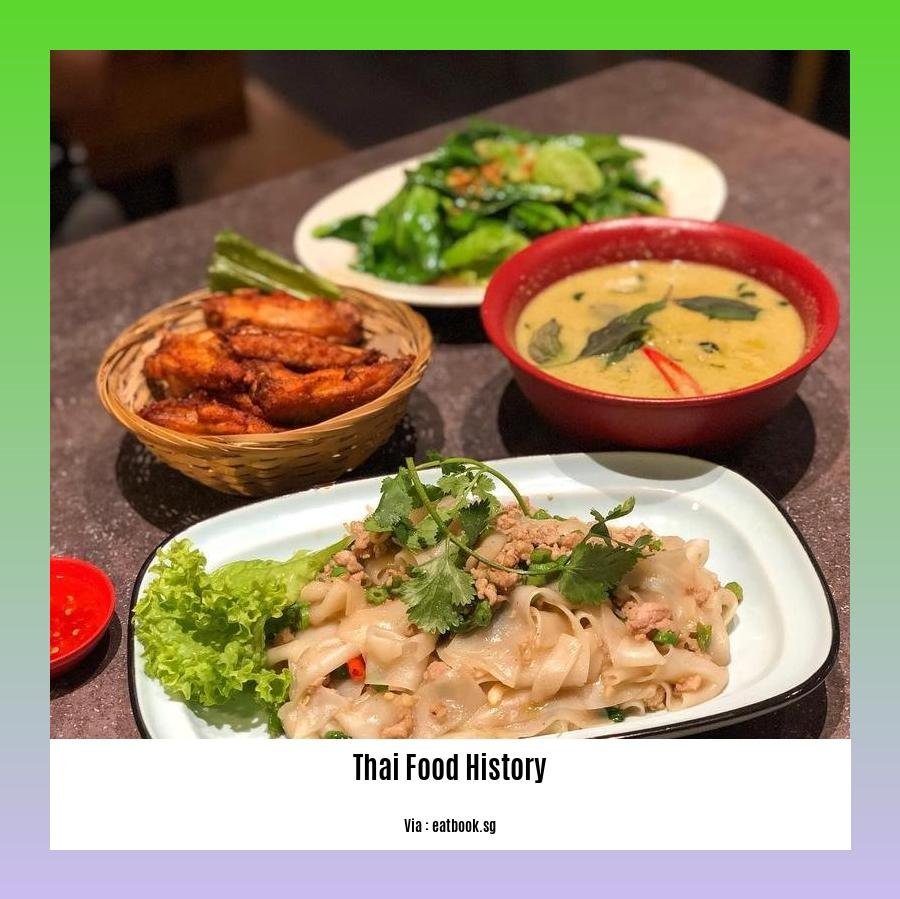
Thai cuisine went through a renaissance when the Rattanakosin Kingdom was founded in the 18th century. Imagine yourself in the heart of Thailand’s capital, Bangkok, during this dynamic period. The city is alive with the sounds of merchants haggling and the aroma of delectable feasts being prepared. It’s a culinary paradise!
Rise of the Royal Cuisine
With the establishment of the new capital, the royal court became the epicenter of culinary innovation. Royal chefs, eager to impress the monarchy, experimented with exotic ingredients and complex techniques, resulting in the creation of unforgettable dishes. Their creativity gave birth to iconic Thai dishes such as Massaman Curry and Gaeng Daeng, a red curry that tantalizes the taste buds with its harmonious blend of flavors.
The royal court’s patronage not only elevated the status of Thai cuisine but also influenced the dining habits of the people. As the aristocracy embraced these culinary masterpieces, they, in turn, became sought after by the masses. This exchange between the court and the commoners led to a vibrant and diverse culinary landscape.
** Fusion of Cultures and Flavors**
The Rattanakosin era witnessed increased trade and cultural exchange with neighboring countries, each bringing its unique culinary influences. Merchants from China, India, and Persia introduced new ingredients and techniques that were eagerly adopted by Thai chefs. This cross-pollination led to the evolution of dishes like Pad See Ew, a noodle dish with Chinese origins, and Khao Soi, a coconut-based curry with Indian roots.
Thai cuisine’s ability to absorb and adapt external influences while retaining its distinct identity is a testament to its versatility and resilience. The flavors of Thailand, with their intricate balance of sweet, sour, salty, and spicy, became a culinary symphony that resonated with people from all walks of life.
A Legacy of Flavors
The Rattanakosin era left an enduring legacy on Thai cuisine, establishing it as one of the most celebrated culinary traditions in the world. The dishes created during this time continue to be enjoyed by Thais and food enthusiasts worldwide.
Whether it’s the fiery heat of a green papaya salad or the soothing sweetness of mango sticky rice, Thai cuisine captivates the senses and leaves an unforgettable impression. It’s a cuisine that has stood the test of time, evolving while staying true to its roots.
Key Takeaways:
- The establishment of the Rattanakosin Kingdom in the 18th century marked a golden age of Thai cuisine.
- Royal patronage and cultural exchange fueled culinary innovation and experimentation.
- The rise of iconic dishes like Massaman Curry and Gaeng Daeng took Thai cuisine to new heights.
- The fusion of flavors from neighboring countries enriched the Thai culinary repertoire.
- Thai cuisine’s enduring legacy continues to delight and inspire food lovers worldwide.
Citations:
- The History of Thai Cuisine:
- Thai Cuisine: A History:
Regional Variations in Thai Cuisine: A Culinary Journey Shaped by Geography, Climate, and Local Ingredients
Key Takeaways:
Regional variations in Thai cuisine arose due to differences in geography, climate, and local ingredients.
Thailand’s four main regions – the North, Northeast, Central, and South – each showcase unique culinary traditions.
Northern Thai cuisine is influenced by neighboring Laos and Myanmar, featuring dishes like khao soi (coconut milk-based curry noodle soup) and sai ua (northern-style sausage).
Northeastern Thai cuisine is known for its spicy and sour dishes, such as som tum (papaya salad) and larb (meat salad).
Central Thai cuisine is the most well-known and popular style, characterized by dishes like pad thai (stir-fried rice noodles) and tom yum goong (hot and sour shrimp soup).
Southern Thai cuisine is known for its use of fresh seafood and coconut milk, with dishes like gaeng tai pla (fish curry) and massaman curry.
Northern Thai Cuisine:
Geography and Climate: The Northern region of Thailand is mountainous and has a cooler climate compared to the rest of the country.
Local Ingredients: Common ingredients include sticky rice, pork, and vegetables like chilies, garlic, and shallots.
Unique Dishes:
- Khao soi: A coconut milk-based curry noodle soup with egg noodles, chicken or beef, and a variety of toppings like crispy noodles, pickled cabbage, and lime wedges.
- Sai ua: A northern-style sausage made with pork, garlic, lemongrass, and kaffir lime leaves.
- Khanom jeen nam ngiao: A fermented rice noodle dish served with a pork and tomato-based sauce.
Northeastern Thai Cuisine:
Geography and Climate: The Northeastern region of Thailand is known for its dry climate and vast rice fields.
Local Ingredients: Sticky rice, chicken, pork, and local herbs and spices like lemongrass, galangal, and kaffir lime leaves are commonly used.
Unique Dishes:
- Som tum: A spicy and sour papaya salad made with shredded green papaya, tomatoes, chilies, garlic, and peanuts.
- Larb: A meat salad made with minced pork or chicken, herbs, spices, and lime juice.
- Gaeng om: A sour and spicy curry made with pork or chicken, bamboo shoots, and vegetables.
Central Thai Cuisine:
Geography and Climate: The Central region of Thailand is home to the capital city of Bangkok and has a tropical climate.
Local Ingredients: Jasmine rice, seafood, coconut milk, and a variety of herbs and spices are commonly used.
Unique Dishes:
- Pad thai: A stir-fried rice noodle dish with eggs, tofu, vegetables, and a sweet and sour tamarind sauce.
- Tom yum goong: A hot and sour shrimp soup made with lemongrass, galangal, kaffir lime leaves, and chili paste.
- Gaeng daeng: A red curry made with beef or pork, bamboo shoots, and red chilies.
Southern Thai Cuisine:
Geography and Climate: The Southern region of Thailand has a tropical climate and a long coastline, influencing its cuisine.
Local Ingredients: Fresh seafood, coconut milk, and a variety of herbs and spices, including turmeric, cumin, and coriander, are commonly used.
Unique Dishes:
- Gaeng tai pla: A fish curry made with fermented fish paste, coconut milk, and vegetables.
- Massaman curry: A rich and flavorful curry made with beef or chicken, coconut milk, potatoes, and peanuts.
- Khao yam: A rice salad made with jasmine rice, fresh herbs, and a spicy dressing.
The culinary landscape of Thailand is a tapestry of flavors and traditions, with each region offering unique dishes that reflect its geography, climate, and local ingredients. From the spicy and sour dishes of the Northeast to the rich and flavorful curries of the South, Thai cuisine offers a culinary adventure that delights the senses and leaves a lasting impression.
Sources:
History of Thai Food: Traditions, Origins, and Influences
FAQ
Q1: What are the key culinary influences that have shaped Thai cuisine?
A1: Thai cuisine is a vibrant blend of diverse culinary traditions, including Chinese, Indian, and Southeast Asian influences. This amalgamation of flavors and techniques has resulted in a unique and harmonious cuisine that is celebrated worldwide.
Q2: How have regional variations influenced Thai cuisine?
A2: The diverse geography and cultural heritage of Thailand have given rise to distinct regional variations in Thai cuisine. The northern region is known for its spicy curries and sausages, while the northeastern region features dishes with fermented ingredients and sticky rice. The central region is famous for its noodle dishes and sweet desserts, and the southern region offers a range of seafood specialties and spicy curries.
Q3: Which dish is considered the national dish of Thailand?
A3: Pad Thai, a stir-fried rice noodle dish with shrimp, chicken, or tofu, vegetables, and a sweet and tangy sauce, is widely regarded as the national dish of Thailand. It is a beloved street food and a symbol of Thai culinary identity.
Q4: What role did the Portuguese play in shaping Thai cuisine?
A4: The Portuguese played a significant role in introducing the chili pepper to Thailand in the 16th century. This ingredient has since become an integral part of Thai cuisine, adding a distinctive spicy flavor to many dishes.
Q5: How has Thai cuisine gained international recognition?
A5: Thai cuisine has gained international recognition for its unique flavors, vibrant colors, and health benefits. Its use of fresh ingredients, balanced flavors, and aromatic herbs and spices has captivated food enthusiasts worldwide, leading to the establishment of Thai restaurants in many countries and a growing appreciation for this culinary gem.
- China II Review: Delicious Food & Speedy Service - April 17, 2025
- Understand Virginia’s Flag: History & Debate - April 17, 2025
- Explore Long Island’s Map: Unique Regions & Insights - April 17, 2025
